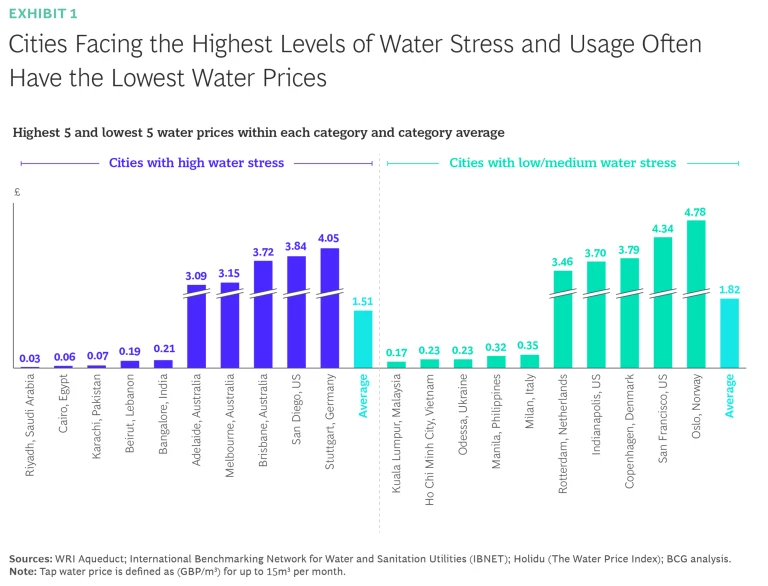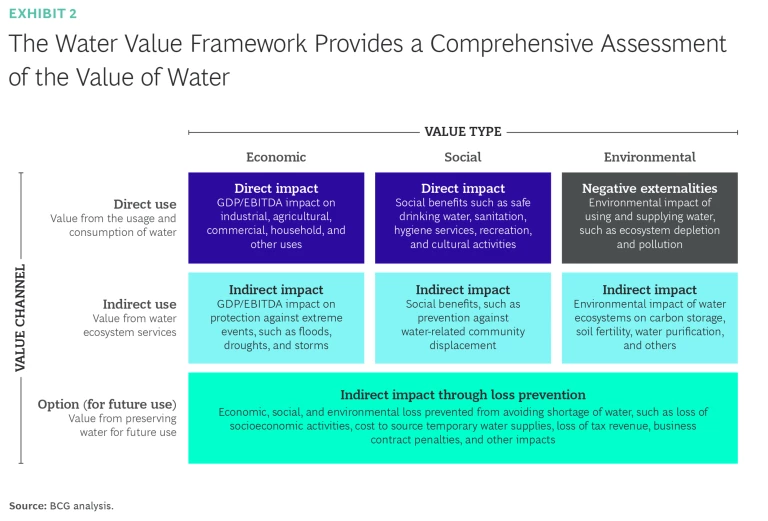How much do you value the water you use? And how much should you pay for it?
Water is a vital resource, essential to economic development, food security, and life itself. Yet the answers to the questions above vary greatly from region to region, which plays a key role in the growing global water crisis. In many parts of the world, water is severely undervalued relative to all the benefits it provides. Because what we pay for it bears so little relation to its true value, we have underinvested in water for decades.
Now, due to over-extraction, increased pollution, and the growing impact of climate change, supplies of water are dwindling even as demand for clean fresh water steadily increases. As water scarcity worsens, it threatens human well-being, economic and political stability, and environmental sustainability. Recognizing and assessing the true value of water, and pricing it accordingly, is a critical step toward driving public awareness of the problem, spurring investment, and improving decision-making related to better managing this resource.
Our recent report on the proper valuation of water examines the urgent nature of the global water crisis and explores the reasons behind its persistent undervaluation and underfunding and the consequences of doing so. We also introduce a framework designed to promote the comprehensive, practical valuation and pricing of water in hopes of catalyzing strategic shifts in water management and investment.
The Global Water Crisis Is Now
The world is facing an intensifying water crisis. Since 1970, renewable water resources have decreased by half due to over-extraction, pollution, and climate change, according to the World Bank. At the same time, the UN reports that global demand for water is increasing by 1% annually. This trend is pushing many regions, both developed and developing, to the brink of water scarcity; by 2050, 46% of global GDP will be concentrated in regions at high risk of water shortages, according to the UN.
The environmental toll is staggering. Since 1970, the World Wildlife Fund reports, freshwater species populations have declined by 83% and one-third of wetlands have disappeared. The social implications are equally troubling, with a quarter of global conflicts over the past 50 years linked to water issues, according to the UN.
Despite the severity of the crisis, investment in water resources remains woefully inadequate. According to UNICEF, achieving universal access to clean drinking water, sanitation, and hygiene services by 2030 will require a fourfold increase in current investment levels—let alone the investment needed for other uses, such as agriculture and industry.
Stay ahead with BCG insights on climate change and sustainability
Systemic Barriers to Water Investment
Several key factors contribute to the underinvestment in water resources. Political, regulatory, and governance challenges complicate the coordination of public investments. And high capital costs, long payback periods, and difficulties with monetization due to regulations and the public, non-financial nature of many benefits can often deter private investment.
At the core of these challenges is the widespread undervaluation and mispricing of water. While closely linked, they differ in key ways:
- Undervaluation reflects the failure to fully recognize and estimate water’s true social, environmental, and economic worth, underpinned by the widespread perception of water as a virtually free, abundant, and always available resource.
- Mispricing refers to flawed pricing mechanisms that do not accurately capture the full benefits of the water supply, the costs of supplying water, and external factors such as environmental impacts of excess groundwater pumping—creating inadequate price and market signals that deter responsible usage, allocation, and investment.
While undervaluation shapes how water is perceived as a resource, mispricing directly affects how it is managed and allocated. Together, these issues create a reinforcing cycle, where the undervaluation of water leads to mispricing, and mispricing further entrenches its undervaluation, perpetuating inefficient use and deepening the global water crisis.
For example, cities facing the highest levels of water stress and usage often have the lowest water prices. (See Exhibit 1.) Water is also clearly undervalued and overlooked compared to other essential utilities such as energy. Responsible use and management of water has received far less public attention, and only 1% of the $53.7 billion invested in climate technology in 2021 went to water, compared to over 25% directed towards energy, according to Bloomberg.

Appropriately valuing and pricing water isn’t easy. Water provides not only economic value, but also value in the form of social and environmental benefits. These include enhancing food security, avoiding potential conflicts, and supporting ecosystems. Recognizing and quantifying these broader impacts, and then presenting them in ways that can guide pricing and investment decisions, is a complex challenge.
Moreover, while utilities typically price water in light of direct costs such as supply, treatment, and infrastructure, this covers only around 22% of the total costs. Indirect costs, including administrative costs and legal expenses, and risk-related costs such as operational downtime and environmental penalties, are frequently omitted from pricing assessments.
In addition, missed environmental and social costs arising from negative externalities are often not considered in the price of water. These include environmental impacts such as over-extraction and pollution from agricultural runoff or industrial discharge, and the resulting loss of biodiversity and ecosystem services such as nutrient deposition.
Finally, the public perception of water as a free and abundant resource can cause resistance to price increases and contribute to its undervaluation. At the same time, concerns about accessibility make it difficult to raise prices without jeopardizing access for vulnerable populations.
The Water Value Framework
To address these valuation challenges, we developed the Water Value Framework, a comprehensive methodology designed to help capture the full value of water in a single view in a specific location or industry, while acknowledging that not all complexities can be fully resolved through this framework.
The framework provides a structured approach to assessing the economic, social, and environmental value of water by considering three ways that water creates value: direct use, indirect use, and availability for use in the future. (See Exhibit 2.) The tool provides two lenses that can be used to inform decision-making:
- Total value. This captures the overall value, measured in dollars, generated by water via its contributions to economies, ecosystems, and societies.
- Marginal value. This reflects the value gained from an additional unit of available water. It is particularly useful for municipalities and companies building business cases for investments in additional water resources, such as water reuse, storage, or desalination infrastructure. Research in Israel, for example, shows that the marginal value of additional water from new desalination plants is $4 per cubic meter, based on avoiding the economic losses from potential future water shortages.

The Benefits of Better Valuation
The appropriate valuation of water is a critical first step to fairly and sustainably pricing water and jump-starting investment to build the infrastructure and develop the products and services required to address the water crisis.
- Optimizing water pricing for sustainability and accessibility. Valuing water accurately allows policymakers to create pricing models that reflect its scarcity and environmental costs while ensuring access for all. Approaches such as variable usage fees and tiered pricing can incentivize conservation and generate additional revenue for future investment by charging higher rates for high-volume users while ensuring that basic water needs remain affordable and accessible to everyone.
- Fostering technological and ecological innovations. Better recognition of water’s value and more appropriate water pricing can help create a clearer picture of financial returns and risks for investors, particularly in long-term infrastructure projects. This could also encourage investments in cutting-edge technologies such as smart water grids, AI-powered management systems, and advanced desalination and wastewater treatment systems. Investments in ecological innovations, such as water-efficient agricultural practices and regenerative farming, also offer significant promise in improving water efficiency.
The full What Is Water Really Worth? report offers case studies, data, and analysis that highlight the ongoing undervaluation of water, applications of the Water Value Framework, and the opportunities that arise when water is valued more accurately.
Charting a Course Forward
The value of water goes beyond its immediate utility; it is a fundamental driver of economic stability, social well-being, and environmental health. A comprehensive approach to water valuation enables public and private sectors to make better decisions on pricing and investments in water innovation. The effort to alleviate the growing water crisis will require well-designed policies and effective execution to drive the right incentives and ensure accessibility outcomes. That, in turn, will lead to a future where water is managed sustainably and efficiently.
This article and the full report were prepared in collaboration with OceanWell.
















